先来c#的,

private void button1_Click(object sender, EventArgs e) { var fileName = @"d:Screenshot4.jpg"; fileName = @"d:Screenshot6.png"; //mat = new Mat(fileName); //pictureBox1.SizeMode = PictureBoxSizeMode.Zoom; //pictureBox1.Image = mat.ToBitmap(); var img = Cv2.ImRead(fileName); var pos = detect(img); foreach (var p in pos) { Debug.WriteLine(p); } } private List<OpenCvSharp.Point> detect(Mat img) { var pos = new List<OpenCvSharp.Point>(); //1.转化成灰度图 Mat gray = img.CvtColor(ColorConversionCodes.BGR2GRAY); //Cv2.CvtColor(img, gray, ColorConversionCodes.BGR2GRAY); //2. 形态学变换的预处理,得到可以查找矩形的图片 Mat dilation = preprocess(gray); //3. 查找和筛选文字区域 var region = findTextRegion(dilation); //4. 用绿线画出这些找到的轮廓 var nrootdir = @"d:/cut_image/"; var nrootdir2 = @"d:/cut_image2/"; int i = 0; int j = 1; foreach (var item in region) { var newimage=img[item.Y>0?item.Y:0, item.Y+item.Height, item.X>0?item.X:0, item.X+item.Width]; //放大4倍 Mat img_gray = new Mat(); //var img_gray = img.Resize(newimage.Size(), 4, 4, InterpolationFlags.Nearest); OpenCvSharp.Size size = new OpenCvSharp.Size(); Cv2.Resize(newimage, img_gray, size, 4, 4, InterpolationFlags.Nearest); var file_name = nrootdir + i.ToString() + ".jpg"; Cv2.ImWrite(file_name, newimage); var file_sub = ""; var gray2 = img_gray.CvtColor(ColorConversionCodes.BGR2GRAY); var dilation2 = preprocess(gray2); var region2 = findTextRegion(dilation2); foreach (var item2 in region2) { var newimage2 = img_gray[item2.Y>0?item2.Y:0,item2.Y+item2.Height, item2.X>0?item2.X:0, item2.X+item2.Width]; if (newimage2.Size().Width > 0) { file_sub = nrootdir2 + i.ToString() + "-" + j.ToString() + ".jpg"; Cv2.ImWrite(file_sub, newimage2); j++; pos.Add(new OpenCvSharp.Point(item.X+item2.X/4+item2.Width/8, item.Y+item2.Y/4+item2.Height/8)); } } //如果第一次检测只有一个文字区域,第二次放大再检测则没有。这样直接复制过去 if (region2 == null || region2.Count == 0) { file_sub = nrootdir2 + i.ToString() + "-0" + ".jpg"; Cv2.ImWrite(file_sub, newimage); pos.Add(new OpenCvSharp.Point(item.X+item.Width/2, item.Y+item.Height/2)); } i++; //画线 //img.Rectangle(item, new Scalar(0, 255, 0), 2); } //Cv2.ImShow("img", img); return pos; } public List<Rect> findTextRegion(Mat dilation) { List<Rect> region = new List<Rect>(); // 1. 查找轮廓 OpenCvSharp.Point[][] contours; HierarchyIndex[] hierarchly; Rect biggestContourRect = new Rect(); Cv2.FindContours(dilation, out contours, out hierarchly, RetrievalModes.CComp, ContourApproximationModes.ApproxSimple); // 2. 筛选那些面积小的 int i = 0; foreach (OpenCvSharp.Point[] contour in contours) { double area = Cv2.ContourArea(contour); //面积小的都筛选掉 if (area < 1000 || area> 10000) { continue; } //轮廓近似,作用很小 double epsilon = 0.001 * Cv2.ArcLength(contour, true); RotatedRect rect = Cv2.MinAreaRect(contour); //找到最小的矩形 biggestContourRect = Cv2.BoundingRect(contour); if (biggestContourRect.Height > (biggestContourRect.Width * 1.2)) { continue; } region.Add(biggestContourRect); } return region; //pictureBox1.Image = mat.ToBitmap(); } private Mat preprocess(Mat gray) { //1.Sobel算子,x方向求梯度 Mat sobel = new Mat(); Cv2.Sobel(gray, sobel, MatType.CV_8U, 1, 0, 3); //2.二值化 Mat binary = new Mat(); Cv2.Threshold(sobel, binary, 0, 255, ThresholdTypes.Otsu | ThresholdTypes.Binary); //3. 膨胀和腐蚀操作的核函数 Mat element1 = new Mat(); Mat element2 = new Mat(); OpenCvSharp.Size size1 = new OpenCvSharp.Size(36, 9); OpenCvSharp.Size size2 = new OpenCvSharp.Size(24, 6); element1 = Cv2.GetStructuringElement(MorphShapes.Rect, size1); element2 = Cv2.GetStructuringElement(MorphShapes.Rect, size2); //4. 膨胀一次,让轮廓突出 Mat dilation = new Mat(); Cv2.Dilate(binary, dilation, element2); //5. 腐蚀一次,去掉细节,如表格线等。注意这里去掉的是竖直的线 Mat erosion = new Mat(); Cv2.Erode(dilation, erosion, element1); //6. 再次膨胀,让轮廓明显一些 Mat dilation2 = new Mat(); Cv2.Dilate(erosion, dilation2, element2, null, 2); return dilation2; }
python3的,

# coding=utf-8 import cv2 import numpy as np import os def preprocess(gray): # 1. Sobel算子,x方向求梯度 sobel = cv2.Sobel(gray, cv2.CV_8U, 1, 0, ksize = 3) # 2. 二值化 ret, binary = cv2.threshold(sobel, 0, 255, cv2.THRESH_OTSU+cv2.THRESH_BINARY) # 3. 膨胀和腐蚀操作的核函数 element1 = cv2.getStructuringElement(cv2.MORPH_RECT, (36, 9)) element2 = cv2.getStructuringElement(cv2.MORPH_RECT, (24, 6)) # 4. 膨胀一次,让轮廓突出 dilation = cv2.dilate(binary, element2, iterations = 1) # 5. 腐蚀一次,去掉细节,如表格线等。注意这里去掉的是竖直的线 erosion = cv2.erode(dilation, element1, iterations = 1) # 6. 再次膨胀,让轮廓明显一些 dilation2 = cv2.dilate(erosion, element2, iterations = 2) # # 7. 存储中间图片 # cv2.imwrite("binary.png", binary) # cv2.imwrite("dilation.png", dilation) # cv2.imwrite("erosion.png", erosion) # cv2.imwrite("dilation2.png", dilation2) return dilation2 def findTextRegion(img): region = [] # 1. 查找轮廓 contours, hierarchy = cv2.findContours(img, cv2.RETR_CCOMP, cv2.CHAIN_APPROX_SIMPLE) # 2. 筛选那些面积小的 for i in range(len(contours)): cnt = contours[i] # 计算该轮廓的面积 area = cv2.contourArea(cnt) # 面积小的都筛选掉 if(area < 1000 or area> 10000): #也过滤太的外框 continue # 轮廓近似,作用很小 epsilon = 0.001 * cv2.arcLength(cnt, True) approx = cv2.approxPolyDP(cnt, epsilon, True) # 找到最小的矩形,该矩形可能有方向 rect = cv2.minAreaRect(cnt) # print ("rect is: ",rect) # box是四个点的坐标 box = cv2.boxPoints(rect) box = np.int0(box) # 计算高和宽 height = abs(box[0][1] - box[2][1]) width = abs(box[0][0] - box[2][0]) # 筛选那些太细的矩形,留下扁的 if(height > width * 1.2): continue region.append(box) return region def detect(img): # 1. 转化成灰度图 gray = cv2.cvtColor(img, cv2.COLOR_BGR2GRAY) # 2. 形态学变换的预处理,得到可以查找矩形的图片 dilation = preprocess(gray) # 3. 查找和筛选文字区域 region = findTextRegion(dilation) # 4. 用绿线画出这些找到的轮廓 for box in region: cv2.drawContours(img, [box], 0, (0, 0, 0), 2) cv2.namedWindow("img", cv2.WINDOW_NORMAL) cv2.imshow("img", img) cv2.waitKey(0) cv2.destroyAllWindows() nrootdir=("d:/cut_image/") if not os.path.isdir(nrootdir): os.makedirs(nrootdir) nrootdir2=("d:/cut_image2/") if not os.path.isdir(nrootdir2): os.makedirs(nrootdir2) pos=[] idx=1 for i in range(0,len(region)): px, py, w, h = cv2.boundingRect(region[i]) #print(i,px,py,w,h) #cv2.rectangle(img, (x,y), (x+w,y+h), (153,153,0), 5) # newimage=img[y+2:y+h-2,x+2:x+w-2] # 先用y确定高,再用x确定宽 newimage=img[py if py>0 else 0:py+h,px if px>0 else 0:px+w] # 放大4倍 img_gray=cv2.resize(newimage,(0,0),fx=4,fy=4,interpolation=cv2.INTER_NEAREST) file_name=nrootdir+str(i)+".jpg" cv2.imwrite(file_name, newimage) gray2 = cv2.cvtColor(img_gray, cv2.COLOR_BGR2GRAY) dilation2 = preprocess(gray2) region2 = findTextRegion(dilation2) for j in range(0,len(region2)): x2, y2, w2, h2 = cv2.boundingRect(region2[j]) cx = x2+w2/2 cy = y2+h2/2 #print(j,x2,y2,w2,h2, (cx, cy)) newimage2=img_gray[y2 if y2>0 else 0:y2+h2,x2 if x2>0 else 0:x2+w2] if newimage2.size>0: file_name=nrootdir2+str(idx)+".jpg" cv2.imwrite(file_name, newimage2) idx+=1 pos.append((px+cx/4,py+cy/4)) return pos # cv2.imwrite("contours.png", img) # cv2.waitKey(0) # cv2.destroyAllWindows() # img = cv2.imread("d:Screenshot1.png") img = cv2.imread("d:Screenshot4.jpg") pos=detect(img) for p in pos: print(p)


然后坐标就得到了
(x:1513 y:955)
(x:1036 y:949)
(x:993 y:944)
(x:811 y:947)
(x:751 y:939)
(x:871 y:934)
(x:815 y:920)
(x:754 y:912)
。。。
还有然后。
